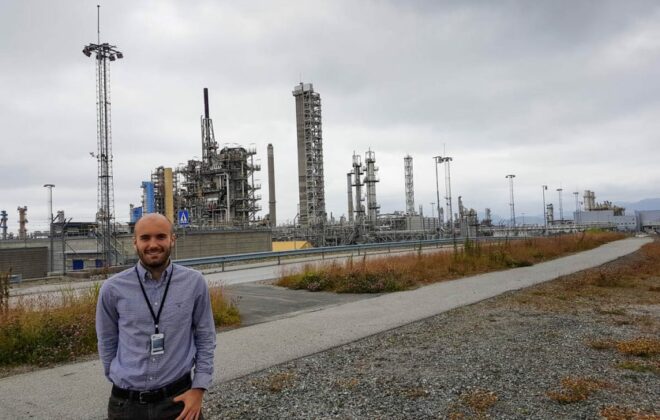Back to the future – Using yesterday’s energy, today!
The storage of renewable energy is essential when aiming to replace readily stored fossil fuels.
More than 80% of the world’s energy consumption is based on fossil energy. Fossils fuels like heavy oils and gasoline are governing the energy market worldwide. There are many environmental implications from burning these fossil fuels. Many people, not only in the research community, but society in general, know that changes to our energy sources must be made.
We have to evolve from ready for tank fossil energy like gasoline towards electric energy from renewable sources like wind and sun. As these energy sources are intermittent and momentaneous, energy storage is needed, so that we can use the renewable energy even when the wind is not blowing, or the sun is not shining. The change we are promoting is elementary as it aims to exchange the fossil-based economy with a hydrogen-based economy.
Fuel cells and hydrogen
Hydrogen can be produced from water and electricity. It can then be stored and transported efficiently to where the energy is required. Fuel cells are then used to convert the energy stored in hydrogen back to electricity.
For the most part, fuel cells can be seen as a black box that you feed with hydrogen and oxygen such that they deliver electricity, heat, and water, as shown in the simplified sketch. The conversion happens via a chemical reaction inside the fuel cell. Especially the chemical reaction in the circle, where the oxygen combines with hydrogen to form water and releases much heat. It is here our research project puts its interest. We are investigating how this heat can and will be transported out of the fuel cell. The heat transfer is necessary because the materials used only withstand certain temperatures before they are destroyed.

Different materials have different capabilities to transport heat; they have different thermal conductivities. These are of interest because ultimately they will govern the temperature distribution in the fuel cell. The majority of my Ph.D. project is focused on determining these thermal conductivities and how their differences will affect the temperature distribution in a fuel cell.
How much heat and power?
The second part of my project is related to finding out how much heat is produced compared to the power the fuel cell delivers. In other words, what is the efficiency of a PEM fuel cell at different operating conditions? This efficiency is a basis for many discussions in forums and online-boards where people are trying to make up their minds about whether to buy an electric car or install solar power on their home roof. It is often misunderstood.

Unlike the Lord of the Rings, there is not one efficiency to rule them all. Various factors can be used to calculate efficiency. In online discussions, this often leads to tweaking the final result in favor of a particular technology by excluding factors from the equation, see the figure above. You could not tell if this comparison was fair without knowing how the efficiencies are calculated. So if you ever discuss efficiency, be sure to know what the discussed results are based on and if they can be compared at all.
Hopes for the future
I do not expect to work with exactly these topics during my entire academic career; however, they do give me a chance to intensively study the field of renewable energy for a period of several years. The project will give me a thorough understanding of the technical challenges we are facing and how to attack them in later projects possibly.
I have high hopes of being able to contribute to the change towards a society based on renewable energy over the length of my career and am positive that our current work at ENERSENSE will be of value.
Blog post originally published on www.ntnutechzone.no on September 19th, 2017

Robert Bock
Robert Bock is a PhD candidate at NTNU – Department of Energy and Process Engineering / ENERSENSE
Search
Søk
Categories
- Arctic Research
- Arkitektur
- Bærekraft
- Bioingeniørfag
- Biologi
- Biology
- Biomedical Laboratory Science
- Biotechnology
- Bioteknologi
- Chemical Engineering
- Chemistry
- Climate
- Computer Science
- Datateknologi
- Digital
- Elektronikk
- Energi
- Energi
- Energy
- Engineering
- Engineering
- Environment
- Food Science
- Forskning
- Fysikk
- Fysikk
- Havbruk
- Informasjonsteknologi
- Informasjonsteknologi
- Ingeniørvitenskap
- Kjemi
- Kjemisk prosessteknologi
- Kjemisk prosessteknologi
- Kreftbehandling
- Kybernetikk
- Marine Technology
- Materialer
- Materials Science
- Materialteknologi
- Matvitenskap
- Meninger
- Miljø
- Min ph.d.
- My PhD
- My PhD
- My postdoc
- Nanotechnology
- Nanoteknologi
- Ocean
- Oil and gas
- Physics
- Research
- Simulering og visualisering
- Spør en forsker
- Studentliv
- Sustainability
- Ukategorisert
- Universitetsliv
- University Life
Kategorier
- Arctic Research
- Arkitektur
- Bærekraft
- Bioingeniørfag
- Biologi
- Biology
- Biomedical Laboratory Science
- Biotechnology
- Bioteknologi
- Chemical Engineering
- Chemistry
- Climate
- Computer Science
- Datateknologi
- Digital
- Elektronikk
- Energi
- Energi
- Energy
- Engineering
- Engineering
- Environment
- Food Science
- Forskning
- Fysikk
- Fysikk
- Havbruk
- Informasjonsteknologi
- Informasjonsteknologi
- Ingeniørvitenskap
- Kjemi
- Kjemisk prosessteknologi
- Kjemisk prosessteknologi
- Kreftbehandling
- Kybernetikk
- Marine Technology
- Materialer
- Materials Science
- Materialteknologi
- Matvitenskap
- Meninger
- Miljø
- Min ph.d.
- My PhD
- My PhD
- My postdoc
- Nanotechnology
- Nanoteknologi
- Ocean
- Oil and gas
- Physics
- Research
- Simulering og visualisering
- Spør en forsker
- Studentliv
- Sustainability
- Ukategorisert
- Universitetsliv
- University Life


